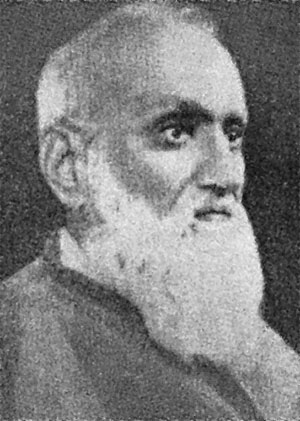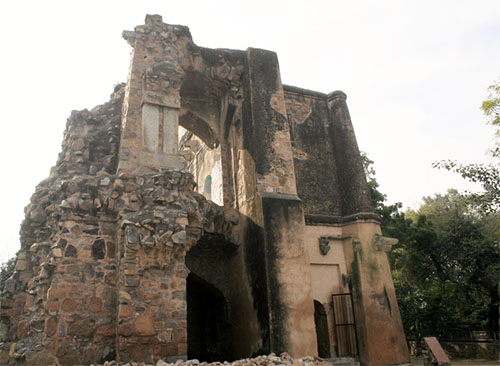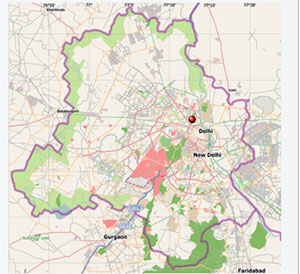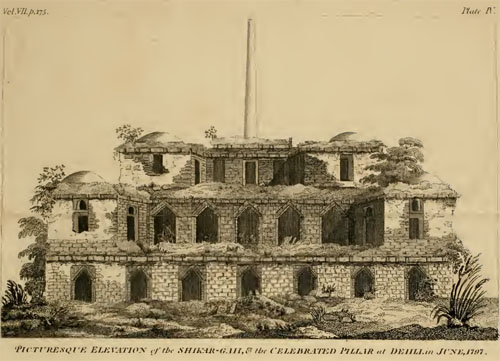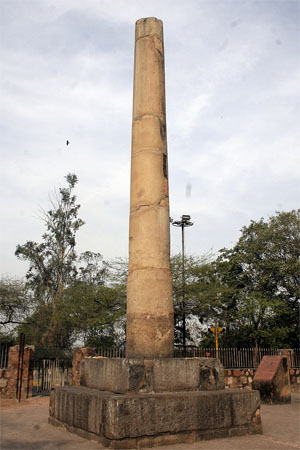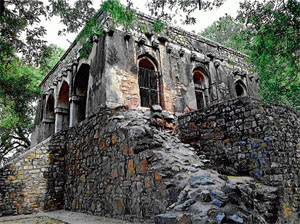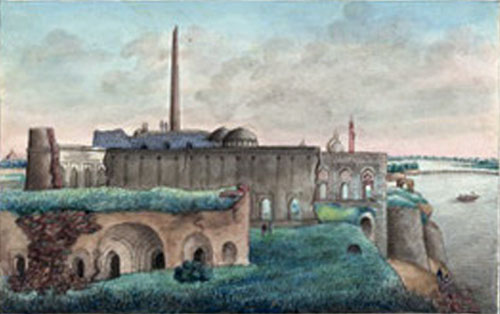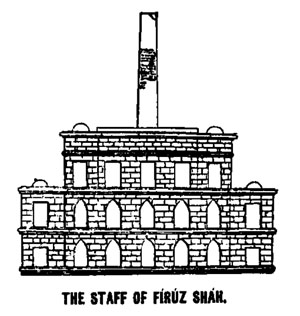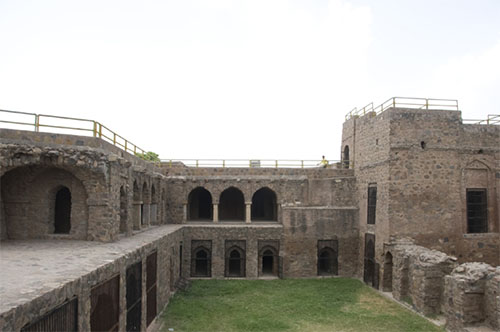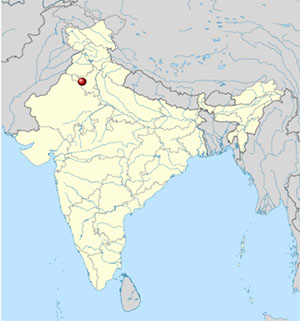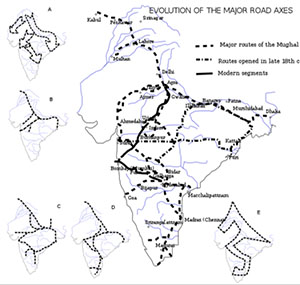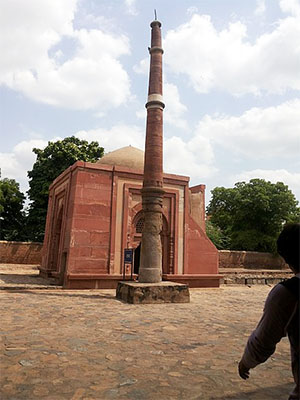Islamic socialism
by Wikipedia
Accessed: 11/13/21
Thirteenth Mukaddama. — Arrival of Sultan Firoz Shah at Dehli.
When the Sultan reached Dehli, the drums of joy were beaten, and the citizens decked themselves out in their jewels and best clothes. Pavilions (kaba) were erected and were decorated according to the custom prevailing in the times of former kings. Six of these pavilions were raised, and for twenty-one days a continual festival was maintained. One lac of tankas was expended in each pavilion in food and sherbet, and no one was excluded....
Fourteenth Mukaddama. — The Sultan's fostering care of the people of Dehli and his remission of arrears.
*** In those days Khwaja Fakhr Shadi was accountant-general. After Sultan Muhammad returned from Daulatabad, he lent the people of Dehli property equivalent to two krors (of tankas?) for the purpose of restoring the land, villages, and quarters which had fallen into ruin during the days of the famine. This money remained in the hands of the people, and Khwaja-i Jahan, after the death of Sultan Mohammad, took the people of Dehli under his protection, and they in their greediness joined themselves to him. When Sultan Firoz ascended the throne at Thatta, the Khwaja distributed jewels and diamonds among them. All the money lent and the jewels stood against the names of the parties concerned in the government books. FakhrShadi, the accountant, brought the fact to the notice of Firoz Shah. After thinking over the matter, the Sultan consulted Kiwamu-l Mulk as to what ought to be done, * * * and that minister replied, "That Sultan Muhammad had deemed it expedient to make loans to the people, and that the Khwaja-i Jahan had squandered the jewels and wealth in prosecution of his projects and vain desires; therefore it would not be seemly to demand their restoration. The people were in great distress and poverty; if such a claim were made, they would be reduced to utter helplessness and ruin, and not one jot of the debt and jewels would be realized." *** The Sultan then asked him how he ought to proceed, and the Khan advised him to have all the accounts brought into the public court, and there to destroy them in the presence of all the people, so that they might be relieved from their great anxiety. The Sultan heartily approved of this advice, and by his direction the records of the debt and of the jewels were brought into his court, where they were publicly cancelled.*** At this time the Sultan appointed Kiwamu-l Mulk his wazir, and bestowed upon him the insignia of his office. * * * The revenues of Dehli, during the forty years which Sultan Firoz reigned, amounted to six krors and seventy-five lacs of tankas (67,500,000).
Fifteenth Mukaddama. — Sultan Firoz makes new rules for grants of revenue.
The Sultan showed great liberality in his grants of revenue, and excited the cupidity of a host of expectants. To some he gave 10,000 tankas, to others 5,000, and to others 2,000, according to the respective ranks and claims of the different office-bearers. This method (of paying officials) was introduced by Sultan Firoz, and remains as a memorial of him. In the reigns of former rulers of Dehli it had never been the rule to bestow villages as stipends upon office-bearers....
[D]uring the forty years of his reign he devoted himself to generosity and the benefit of Musulmans, by distributing villages and lands among his followers. In the whole of these forty years not one leaf of dominion was shaken in the palace of sovereignty. These facts are among the glories of his reign. ***
Another law made by Firoz Shah was this: If an officer of the army died, he was to be succeeded by his son; if he had no son, by his son-in-law; if he had no son-in-law, by his slave (ghulam); if he had no slave, by his nearest relation; and if he had no relations, by his wives. During the whole of his reign he made it a rule that, under all circumstances, the succession of every person should be clearly defined. ***
Sixteenth Mukaddama. — Sultan Firoz's fostering care of his subjects.
* * * Unwise regulations had been made in former reigns, and the raiyats and subjects were oppressed in the payment of the revenue. Several writers told the author of this work that it was the practice to leave the raiyat one cow and take away all the rest. Sultan Firoz made the laws of the Prophet his guide, acting zealously upon the principles they laid down, and prohibiting all that was inconsistent therewith.
No demand in excess of the regular government dues was to be made, and the officer who made any such exaction was to make full reparation. Brocades, silks, and goods required for the royal establishments were to be purchased at the market price, and the money paid. *** Such rules were made that the raiyats grow rich, and were satisfied. *** Their homes were replete with grain, property, horses, and furniture; every one had plenty of gold and silver; no woman was without her ornaments, and no house was wanting in excellent beds and coaches. Wealth abounded and comforts were general. The whole realm of Dehli was blessed with the bounties of the Almighty....
Second Mukaddama. — The Sultan's care to provide slaves (bandagan).
The Sultan was very diligent in providing slaves, and he carried his care so far as to command his great fief-holders and officers to capture slaves whenever they were at war, and to pick out and send the best for the service of the court. When the feudatories went to court, each one according to his ability took with him beautiful slaves, dressed and ornamented in the most splendid style. They also, when they paid their annual visit, brought other presents suited to their means and station — high-priced horses of the best breeds, fine elephants, valuable garments of every kind, vessels of gold and silver, arms, camels and mules,— each man according to the extent of his fief, some as many as a hundred, some fifty, some twenty, and some eleven. They also brought slaves. Under an edict of the Sultan, all the presents which the feudatories brought were valued, and the amount was deducted from the dues payable by them to the Government. This was a regulation established by Sultan Firoz. Before his time, in the reigns of his predecessors, the feudatories brought whatever they could, but no remission in their payments was made in consideration of their presents. Sultan Firoz saw that the expenses of his feudatories were very large, and decreed that they should not be required to make presents.
From this arrangement two advantages were expected — the chieftains' pride would be spared (the fear of being outdone), and the gifts themselves would be more worthy of the Sultan's notice. This regulation remained in force for forty years throughout the reign. Those chiefs who brought many slaves received the highest favour, and those who brought few received proportionately little consideration. When the chiefs perceived the Sultan's eagerness for slaves, and that their efforts to get them were highly appreciated, they exerted themselves in providing them, and the numbers brought every year exceed description. Great numbers of slaves were thus collected, and when they were found to be in excess, the Sultan sent them to Multan, Dipalpur, Hisar-Firozah, Samana, Gujarat, and all the other feudal dependencies. In all cases provision was made for their support in a liberal manner. In some places they were provided for in the army, and villages were granted to them; those who were placed in cities had ample allowances, varying from 100 down to 10 tankas, which was the lowest amount. These allowances were paid in full, without any deduction, at the treasury, every six, four, or three months.
Some of the slaves spent their time in reading and committing to memory the holy book, others in religious studies, others in copying books. Some, with the Sultan's leave, went to the temple at Mecca. Some were placed under tradesmen and were taught mechanical arts, so that about 12,000 slaves became artisans (kasib) of various kinds. Forty thousand were every day in readiness to attend as guards in the Sultan's equipage or at the palace. Altogether, in the city and in the various fiefs there were 180,000 slaves, for whose maintenance and comfort the Sultan took especial care. The institution took root in the very centre of the land, and the Sultan looked upon its due regulation as one of his incumbent duties. To such an extent were matters carried that there was a distinct muster-master (majmu'-dar) of the slaves, a separate treasury for the payment of their allowances, a separate jao-shughuri, and deputy jao-shughuri,1 [The signification of this is obscure, and the copyists seem to have so deemed it. The word by the majority is written [x]; but one varies, and gives it as [x].] and a distinct diwan, that is to say, the officers for administering the affairs of the slaves (ashab-i diwan-i bandagan), were entirely distinct from those under the Prime Minister (ashab-i diwan-i 'ala-e wizarat).
When the Sultan went out in state the slaves accompanied him in distinct corps — first the archers, fully armed, next the swordsmen, thousands in number (hazar hazar), the fighting men (bandagan-i award), the bandagan-i mahili1 [[x].] riding on male buffaloes, and slaves from the Hazara, mounted on Arab and Turki horses, bearing standards and axes. These all, thousands upon thousands, accompanied the royal retinue. The slaves increased to such a degree that they were employed in all sorts of domestic duties, as water coolers, butlers [etc., etc.]. In fact there was no occupation in which the slaves of Firoz Shah were not employed. None of the Sultan's predecessors had ever collected so many slaves. The late Sultan 'Alau-d din had drawn together about 50,000 slaves, but after him no Sultan had directed his attention to raising a body of them until Sultan Firoz adopted the practice. *** When the slaves under the great feudal chieftains became too numerous, some of them, by order of the Sultan, were given into the charge of amirs and maliks, that they might learn the duties of their respective employments. These amirs and maliks treated them like children, providing them with food and raiment, lodging them and training them, and taking every care for their wants. Each year they took their slaves to court, and reported upon their merits and abilities. These reports were received by the Sultan with great interest. Such was the care and attention which Sultan Firoz devoted to his slaves; but after his death, the heads of these his favoured servants were cut off without mercy, and were made into heaps in front of the darbar, as I will describe in my chapter on the reign of Sultan Muhammad bin Firoz...
Fifth Mukaddama. — Prosperity and happiness of the nobles.
During the reign of Firoz Shah *** all men, high and low, bond and free, lived happily and free from care. *** When the Sultan went to the palace, at the "grand city" of Firozabad, the Khan-i Jahan used to make preparations some days beforehand for his reception, by having the palace whitewashed and ornamented with pictures. Every possible care was taken by the Khan for the proper reception of the Sultan. [Splendour and ceremonial of the Court. Easy condition of the people.] Things were so plentiful and cheap; and the people were so well to do, and enjoyed much ease, that the poorest married their daughters at a very early age. Nothing in the least degree unpleasant or disagreeable happened during his reign; how wonderful is it that, since his decease, the city of Dehli has been turned upside down. Those who survive will ever call to mind the reign of Firoz Shah, and exclaim, "The reign of Firoz will always dwell upon the memory, and can never be forgotten."
Sixth Mukaddama. -- The plenty and cheapness in the reign of Firoz Shah.
By the blessing of God favourable seasons and abundance of the necessaries of life prevailed in the reign of Firoz Shah, not only in the capital, but throughout his dominions. During the whole forty years of his reign there was no appearance of scarcity, and the times were so happy that the people of Dehli forgot the reign of 'Alau-d din, although no more prosperous times than his had ever fallen to the lot of any Muhammadan sovereign. 'Alau-d din took such pains to keep down the price of the necessaries of life, that his exertions have found a record in famous histories. To the merchants he gave wealth, and placed before them goods in abundance, and gold without measure. He showed them every kingly favour, and fixed on them regular salaries.1 [Mawajib, salaries, allowances, or pensions.]
In the reign of 'Alau-d din the necessaries of life were abundant through excellent management,1 [["Ba hikmat'i kibriyai." These words may be translated "by Divine wisdom," but they are evidently used antithetically to the ''baghair koshish," or "absence of effort" on the part of Firoz].] but through the favour of God grain continued cheap throughout the reign of Firoz Shah, without any effort on his part. Grain was so cheap that, in the city of Dehli, wheat was eight jitals a man, and gram and barley four jitals a man. A camp follower could give his horse a feed of ten sirs of corn (dalida) for one jital. Fabrics of all kinds were cheap, and silk goods, both white and coloured, were of moderate price. Orders were given for the reduction of the price of sweetmeats, in unison with the general fall of prices.
During the forty years of this sovereign's reign, cheapness prevailed. If occasionally prices rose from bad seasons, or from scarcity of rain, and reached one tanka per man, it was only for a short time. The good fortune of the Sultan prevailed, so that no dearth occurred. Such was the prosperity that, throughout the Doab, from the hill of Sakrudih and Kharla to Kol, not one village remained waste, even in name, nor one span of land uncultivated. In the Doab there were fifty-two parganas flourishing, and a similar (state of prosperity) prevailed elsewhere. The like prosperity prevailed in every fief (ikta'a) and district (shikk). Thus, in the district of Samana, there were four prosperous villages within one kos, and the inhabitants were happy and free from care. Such perfect happiness did the kingdom enjoy in those days.
Sultan Firoz had a great liking for the laying out of gardens, which he took great pains to embellish. He formed 1,200 gardens in the vicinity of Dehli. Such of them as were private property, or were religious endowments, after2 [Three of the MSS. have ''[x], without;" while the fourth (East India Library, No. 1002) says "[x], after" verification of titles. The latter is certainly most probable.] due investigation of the titles, he settled for with their owners. All gardens received abundant proofs of his care,1 [The text is a little confused here. I have ventured upon one emendation in reading [x], instead of [x], etc., etc. All the MSS. concur in the latter reading, although it seems to make nonsense.] and he restored thirty gardens which had been commenced by 'Alau-d din. In the neighbourhood of Salaura he made eighty gardens, and in Chitur forty-four gardens. In every garden there were white and black grapes, of seven [named] varieties. They were sold at the rate of one jital per sir. Of the various articles grown in the gardens, the government share of the produce amounted to 80,000 tankas, without taking into account the dues of the owners and gardeners.
The revenues of the Doab in this reign amounted to eighty lacs of tankas; and under the fostering care of this religious sovereign, the revenues of the territories of Dehli were six krors and eighty-five lacs of tankas (60,850,000). The Sultan, throughout his reign, in his great sagacity and prudence, endeavoured to circumscribe the extent of his dominions, but still the revenues amounted to the sum stated. All this large revenue was duly apportioned out; each Khan received a sum suitable to his exalted position, the amirs and maliks also obtained allowances according to their dignity, and the officials were paid enough to provide a comfortable living. The soldiers of the army received grants of land, enough to support them in comfort, and the irregulars (ghair wajh) received payment from the government treasury. Those soldiers who did not receive their pay in this manner were, according to necessity, supplied with assignments (itlak) upon the revenues. When these assignments of the soldiers (wajh-dars) arrived in the fiefs (ikta'at), the holders used to get about half of the total amount from the holders of the fiefs. It was the practice of certain persons in those days to buy up these assignments, which was an accommodation to both parties. They used to give one-third of the value for them in the city, and receive one half in the districts. The purchasers of these assignments carried on a traffic in them, and gaining a good profit, many of them got rich and made their fortunes.
Sultan Firoz, under Divine inspiration, spread all the revenues of his territories among his people. The various districts of the fiefs were also divided. Khan-i Jahan, the wazir, exclusive of the allowances for his retainers, friends, and sons, received a sum of thirteen lacs of tankas, or instead of it sundry fies and districts. Other chiefs were similarly provided for, according to their merit; some receiving eight lacs of tankas, others six lacs, and others four lacs. All the khans and maliks grew rich in his reign, and had vast stores of wealth, and jewels and diamonds of great value. When Malik Shahin Shahna, who was naib-amir of the majlis-i khass, died, and his effects were examined, a sum of fifty lacs of tankas, in cash, was taken out of his house, besides horses, valuables, and jewels in abundance. The enormous wealth left by 'Imadu-l Mulk, Bashir-i Sultani, was well known, and is well remembered. An account of it will be given in the fifth book of this work. The Sultan being thus beneficent, all men, high and low, were devoted to him....
Twelfth Mukaddama. — Consideration of the Sultan for the unemployed.
*** The Sultan gave directions that when there were any workmen out of employ in the city they were to be sent to him. The kotwal used to call his district officers before him, and make enquiries of them. The most respectable people, out of shame, would not make their necessities known, and such gentlemen as these were brought to the kotwal by his officers.*** When they were brought before the Sultan they were all placed in employ. Men of the pen were sent into the Government establishments (kar-khana), intelligent men of business were placed under the Khan-i Jahan, if any one expressed a desire to be made the slave (banda) of any particular nobleman, the Sultan himself used to send a letter of recommendation to that noble; and if one desired to be made the slave (banda) of an amir who held a fief (ikta'), a farman was sent to that amir, and the applicant proceeded thither. So, few persons remained without employment, and wherever one of the unemployed was sent, there he found a comfortable settlement....
Fifteenth Mukaddama. — Establishment of a House of Charity and a Hospital.
Sultan Firoz founded an establishment (diwan-i khairat) for the promotion of marriages. Many needy Musulmans were distressed at having marriageable daughters, for whom they could provide no marriage portion. *** Notice was given that any man having a marriageable daughter might apply at the diwan-i khairat and state his case and his poverty to the officers of that establishment, *** who, after due enquiry, might fix an allowance of fifty tankas for the first class of recipients, thirty for the second, and twenty-five for the third. *** People, small and great, flocked to the city from all parts of the country, and received grants for purchasing housekeeping requisites for their daughters. ***
The Shifa-khana, or Hospital, also called, Sihhat-khana. *** The Sultan, in his great kindness and humanity, established a hospital for the relief of the sick and afflicted, whether natives (ashna) or strangers. Able physicians and doctors were appointed to superintend it, and provision was made for the supply of medicines. The poor afflicted went to the hospital and stated their cases. The doctors duly considered and applied their skill to the restoration of health. Medicines, food, and drinks were supplied at the expense of the treasury. ***
When the Sultan founded these institutions for the public benefit he settled some rich and well cultivated villages upon them, to provide for their expenses. Allowances were also granted to learned men and Kuran readers. The author has understood from the best authority that the sum of thirty-six lacs of tankas out of the revenues of the kingdom were appropriated to the payment of wages (idrar), and that 4,200 afflicted persons received these monthly allowances.
-- XVI. Tarikh-i Firoz Shahi, of Shams-i Siraj 'Afif, Excerpt from The History of India As Told By Its Own Historians: The Muhammadan Period, edited from the posthumous papers of the Late Sir H.M. Elliot, K.C.B., East India Company's Bengal Civil Service, by Professor John Dowson, M.R.A.S., Staff college, Sandhurst, Vol. III, P. 269-364, 1871
Islamic socialism is a political philosophy that incorporates Islamic principles into socialism. As a term, it was coined by various Muslim leaders to describe a more spiritual form of socialism. Islamic Socialists also often use the Quran to defend their positions. A Turkish Islamic socialist organisation, Anti-capitalist Muslims, openly challenged right-wing Muslims to read the Quran and "try to disprove the fact that it is leftist".[1]
Muslim socialists believe that the teachings of the Quran and Muhammad—especially the zakat—are not only compatible with principles of socialism, but also very supportive of them. They draw inspiration from the early Medinan welfare state established by Muhammad. Muslim socialists found their roots in anti-imperialism. This can especially be seen in the writings of Salama Moussa [1887 – 4 August 1958], who wrote extensively both about socialism, and about Egyptian Nationalism against British rule.[2]
Muslim socialist leaders believe in the derivation of legitimacy from the public, and wish to implement a government based on social welfare and the concept of zakat. In practice, this has been seen through guaranteed incomes, pensions, and welfare. These practical applications of the idea of Islamic Socialism have a history going back to Muhammad and the first few Caliphates, to modern political parties founded in the 1970s.
Abū Dharr al-Ghifārī, a companion of Muhammad, is credited by some scholars, like Muhammad Sharqawi and Sami Ayad Hanna, as a principal antecedent of Islamic socialism.[3][4][5][6][7] He protested against the accumulation of wealth by the ruling class during Uthman's caliphate and urged the equitable redistribution of wealth. The first Muslim Caliph Abu Bakr introduced a guaranteed minimum standard of income, granting each man, woman and child ten dirhams annually—this was later increased to twenty dirhams.[8]
According to Sami A. Hanna and Hanif Ramay, one of the first expressions of Islamic socialism was the Wäisi movement in Tatarstan, Russia in the late 19th and early 20th centuries.
The Wäisi movement was a religious, social and political movement in Tatarstan and other Tatar-populated parts of Russia which took place in the late 19th and early 20th centuries. It also incorporated elements of class struggle and nationalism. The primary founder of the movement was Bahawetdin Wäisev. It was related to other movements among Muslims in the Russian Empire and the Soviet Union, such as the Jadid movements.
This movement enjoyed widespread popularity and united Tatar farmers, craftsmen and petty bourgeoisie. After the arrest of Bahawetdin Wäisev in 1884, the number of members remained high. In 1908, there were nearly 15,000 followers in the Kazan Governorate (especially Kazan, Sviyajsk, Arsk uyezds), Orenburg, and other guberniyas, in Central Asia.
The main doctrines of Wäisi were disobedience to civil laws and administration, adherence to the Sharia and Qur'an rather than government regulations, evasion of service in the "kafir" army and of paying imposition, and refusal to obtain the Russian passport featuring a double-headed eagle. After the arrest of Bahawetdin Wäisev and some other leaders, the remaining membership switched to underground work. In 1897, 100 followers of Wäisi were arrested and exiled after they encouraged people not to participate in the population census. Bahawetdin Wäisev died in 1893 during his incarceration. At the beginning of the 20th century his son Gainan assumed the leadership of the movement.
After the First Russian revolution in 1905-1907 the Wäisi movement increased in size and was renovated and reconstituted as Islamic Socialism. After the October Revolution of 1917, Waisi followers supported the Soviet government. Mirsaid Sultan-Galiev and Mullanur Waxitov were among its most influential followers, organising the Muslim Socialist Committee of Kazan. During the Civil War in Russia, Wäisi followers organized a regiment in the Red Army. On February 28th, 1918, Ğainan Wäisev was assassinated by unknown assailants. In the 1920s, Wäisi movement followers founded the Yaña Bolğar (New Bolghar) commune in Chistopol canton in order to foster the growth of an autonomous Wäisi community. But in the 1930s during the Great Purge, the Wäisis were repressed and the movement faded away.
-- Wäisi movement, by Wikipedia
The movement opposed the rule of the Russian Empire and was supported by Muslim farmers, peasants and petite bourgeoisie. It suffered repression by the Russian authorities and went underground in the early 20th century, when it started cooperating with communists, socialists and social democrats in anti-government activity, and started identifying itself as an Islamic socialist movement in the wake of the 1905 Russian Revolution. The movement aligned with the Bolsheviks during the Russian Revolution of 1917,[9] during which the movement also established the first experimental Islamic commune. The Muslim Socialist Committee of Kazan was also active at this time. After the death of Lenin in 1924, the Wäisi movement asserted its independence from the Communist Party, however it was suppressed during the Great Purge in the 1930s.[9]
Soviet decision makers recognized that revolutionary activity along the Soviet Union's southern border would draw the attention of capitalist powers and invite them to intervene. It was this understanding which prompted the Russian representation at the Baku Congress in September 1920 to reject the arguments of the national communists as impractical and counterproductive to the revolution in general, without elaborating their fear that the safety of Russia lay in the balance. It was this understanding, coupled with the Russian Bolsheviks' displeasure at seeing another revolutionary center proposed in their own domain revolutionary, that galvanized them into action against the national communists.[10]
The Iranian intellectual Muhammed Nakhshab is credited with the first synthesis between Shi'ism and European socialism.[11] Nakhshab's movement was based on the tenet that Islam and socialism were not incompatible since both sought to accomplish social equality and justice. His theories had been expressed in his B.A. thesis on the laws of ethics.[12] In 1943, Nakhshab founded the Movement of God-Worshipping Socialists, one of six original member organizations of the National Front.[13]
The National Front of Iran is an opposition political organization in Iran, founded by Mohammad Mosaddegh in 1949. It is the oldest and arguably the largest pro-democracy group operating inside Iran despite having never been able to recover the prominence it had in the early 1950s.
Initially, the front was an umbrella organization for a broad spectrum of forces with nationalist, liberal-democratic, socialist, bazaari, secular and Islamic tendencies, that mobilized to successfully campaign for the nationalization of the Iranian oil industry. In 1951, the Front formed a government which was deposed by the 1953 Iranian coup d'état and subsequently repressed. Members attempted to revive the Front in 1960, 1965 and 1977.
Before 1953 and throughout the 1960s, the Front was torn by strife between secular and religious elements; over time its coalition split into various squabbling factions, with the Front gradually emerging as the leading organization of secular liberals with nationalist members adhering to liberal democracy and social democracy.
During the Iranian Revolution, the Front supported the replacement of the old monarchy by an Islamic Republic and was the main symbol of the "nationalist" tendency in the early years of post-revolutionary government. It was banned in July 1981, and although it remains under constant surveillance and officially it is still illegal, it is still active inside Iran.
-- National Front (Iran), by Wikipedia
The organization was founded through the merger of two groupings, Nakhshab's circle of high school students at Dar al-Fanoun and Jalaleddin Ashtiyani's circle of about 25 students at the Faculty of Engineering at Tehran University. The organization was initially known as League of Patriotic Muslims. It combined religious sentiments, nationalism and socialist thoughts.[14] After the 1953 coup against the National Front-led government of Mohammad Mosaddegh, Islamic socialism in Iran took a more radical turn, with the People's Mujahedin of Iran formed in 1965 fusing Islamic imagery and language with Marxist ideas under the influence of Ali Shariati and engaging in armed struggle against the government of the Shah of Iran, culminating in its participation in the Iranian Revolution which overthrew the Shah in 1979. However the movement fell foul of the Islamic Republic established after the Revolution, and took up arms against the new government.[9]
In South Asia, the Deobandi scholar and Indian independence activist Ubaidullah Sindhi travelled to Russia via Afghanistan in the 1910s. He remained in post-revolution Russia until 1923, where he studied socialism and engaged in discussions with communist revolutionaries. From Russia he moved on to Turkey, where he developed his ideas on Islamic socialism, drawing parallels between Islam and communism in their emphasis on the fair distribution of wealth.[9]
Maulana Ubaidullah Sindhi
Buta Singh Uppal, later known as Maulana Ubaidullah Sindhi, (10 March 1872 – 21 August 1944) was a political activist of the Indian independence movement and one of its vigorous leaders. According to Dawn, Karachi, Maulana Ubaidullah Sindhi struggled for the independence of British India and for an exploitation-free society in India. He was also Home Minister of first Provisional Government of India established in Afghanistan in 1915.[4]
Maulana Ubaidullah Sindhi was the Life Member of Jamia Millia Islamia, A Central University in New Delhi, India.Jamia Millia Islamia is a central university located in New Delhi, India. Originally established at Aligarh, United Provinces (present day Uttar Pradesh, India) during the British Raj in 1920, it moved to its current location in Okhla in 1935....
Jamia Millia Islamia was established in Aligarh on 29 October 1920 by Mohammad Ali Jauhar, Hakim Ajmal Khan, Mukhtar Ahmed Ansari, Abdul Majeed Khwaja, and Zakir Hussain under the presidency of Mahmud Hasan Deobandi. It was established mainly in response to the demand of some students of the Aligarh Muslim University for a new National Muslim University which would be free from government influence as they felt that the administration of Aligarh Muslim University was of pro-British stance.It was Ahmed Khan who, with the help of Captain Nassau Lees and Maulvi Kabiruddin Ahmed, compiled the first printed edition of the Persian text of the Tarikh, using one complete manuscript and three incomplete manuscripts to finish what Ishtiyaq Ahmad Zilli tells us is the first Persian edited text. It was published by the Asiatic Society of Bengal (Calcutta) in 1862 and was one of the achievements which earned him his Fellowship of the Royal Asiatic Society.
-- Traces of the Great: A medieval history of the Delhi Sultanate, by Francis Robinson
It was conceived as a national institution that would offer progressive education and an emphasis on Indian nationalism to students from all communities, particularly Muslims. Zakir Hussain described "the movement of Jamia Millia Islamia as a struggle for education and cultural renaissance that aims to prepare a blueprint for Indian Muslims which may focus on Islam but simultaneously evolve a national culture for common Indian. It will lay the foundation of the thinking that true religious education will promote patriotism and national integration among Indian Muslims, who will be proud to take part in the future progress of India, which will play its part in the comity of nations for peace and development. The objective of establishment of Jamia Millia Islamia will be to lay down the common curriculum for Indian Muslims taking into account the future challenges and will prepare the children to be masters of future"[3] The emergence of Jamia was supported by Mahatma Gandhi[9][10][11][12] and Rabindranath Tagore who felt that Jamia Millia Islamia could shape lives of hundreds and thousands of students on the basis of a shared culture and worldview.
In 1925, Jamia Millia Islamia moved from Aligarh to Karol Bagh, New Delhi. On 1 March 1935, the foundation stone for a school building was laid at Okhla, then a nondescript village in the southern outskirts of Delhi. In 1936, all institutions of Jamia Millia Islamia except Jamia Press, the Maktaba, and the library moved to the new campus.
-- Jamia Millia Islamia, by Wikipedia
He served the Jamia Millia Islamia for a long period of time on a very low salary. A boys' hostel in Dr. Zakir Husain Hall of Boys' Residence in Jamia Millia Islamia has been named after him....
Buta Singh Uppal converted to Islam at age 15 and chose "Ubaidullah Sindhi" as his new name, and later enrolled in the Darul Uloom Deoband, where he was, at various times, associated with other noted Islamic scholars of the time, including Maulana Rasheed Gangohi and Maulana Mahmud al-Hasan. Maulana Sindhi returned to the Darul Uloom Deoband in 1909, and gradually involved himself in the Pan-Islamic movement. During World War I, he was among the leaders of the Deoband School, who, led by Maulana Mahmud al-Hasan, left India to seek support among other nations of the world for a Pan-Islamic revolution in India in what came to be known as the Silk Letter Conspiracy.
Ubaidullah had reached Kabul during the war to rally the Afghan Amir Habibullah Khan, and after a brief period there, he offered his support to Raja Mahendra Pratap's plans for revolution in British India with German support. He joined the Provisional Government of India formed in Kabul in December 1915, and remained in Afghanistan until the end of World War I, and then left for Russia. He subsequently spent two years in Turkey and, passing through many countries, eventually reached Hijaz (Saudi Arabia) where he spent about 14 years learning and pondering over the philosophy of Islam especially in the light of Shah Waliullah Dehlawi's works. In his career, he was a Pan-Islamic thinker....
When he was at school, a Hindu friend gave him the book Tufatul Hind to read. It was written by a converted scholar Maulana Ubaidullah of Malerkotla. After reading this book and some other books like Taqwiyatul Eeman and Ahwaal ul Aakhira, Ubaidullah's interest in Islam grew, leading eventually to his conversion to Islam. In 1887, the year of his conversion, he moved from Punjab to Sindh area where he was taken as a student by Hafiz Muhammad Siddique of Chawinda (Bhar Chandi Shareef). He subsequently studied at Deen Pur Shareef (a village near Khanpur, Distt Rahim Yar Khan) under Maulana Ghulam Muhammad R.A, Where he delved deeper into Islamic education and training in the mystical order. In 1888, Ubaidullah was admitted to Darul Uloom Deoband, where he studied various Islamic disciplines in depth under the tutelage of noted Islamic scholars of the time including Maulana Abu Siraj, Maulana Rasheed Ahmad Gangohi and Maulana Mahmud al Hasan. He took lessons in Sahih al-Bukhari and Tirmidhi from Maulana Nazeer Husain Dehalvi and read logic and philosophy with Maulana Ahmad Hasan Cawnpuri.
In 1891, Ubaidullah graduated from the Deoband school. He left for Sukkur area in Sindh province, and started teaching in Amrote Shareef under, or with, Maulana Taj Mohammad Amrothi, who became his mentor after the death of Hafiz Muhammad Siddique of Bhar Chandi. Ubaidullah married the daughter of Maulana Azeemullah Khan, a teacher at Islamiyah High School, at that time. In 1901, Ubaidullah established the Darul Irshaad in Goth Peer Jhanda village in Sindh. He worked on propagating his school for nearly seven years. In 1909, at the request of Mahmud Al Hasan, he returned to Deoband School in Uttar Pradesh. Here, he accomplished much for the student body, Jamiatul Ansaar. Ubaidullah was now very active in covert anti-British propaganda activities, which led to him alienating a large number of the Deoband School leaders. Subsequently, Ubaidullah moved his work to Delhi at Mahmud al Hasan's request. At Delhi, he worked with Hakim Ajmal Khan and Dr. Ansari. In 1912, he established a madrassah, Nazzaaratul Ma'arif, which was successful in propagating and spreading Islam among the people.
With the onset of World War I in 1914, efforts were made by the Darul Uloom Deoband to forward the cause of Pan-Islam in British India with the help of the other sympathetic nations of the world. Led by Mahmud al Hasan, plans were sketched out for an insurrection beginning in the tribal belt of North-West Frontier Province of British India. Mahmud al Hasan, left India to seek the help of Galib Pasha, the Turkish governor of Hijaz, while at Hasan's directions, Ubaidullah proceeded to Kabul to seek Emir Habibullah's support there. Initial plans were to raise an Islamic army (Hizb Allah) headquartered at Medina, with an Indian contingent at Kabul. Maulana Hasan was to be the General-in-chief of this army. Some of Ubaidullah's students went to Kabul to explore things before Ubaidullah arrived there. While at Kabul, Ubaidullah came to the conclusion that focusing on the Indian Freedom Movement would best serve the pan-Islamic cause. Ubaidullah had proposed to the Afghan Emir that he declare war against British India. Maulana Abul Kalam Azad is known to have been involved in the movement prior to his arrest in 1916.
Maulana Ubaidullah Sindhi and Mahmud al Hasan (principal of the Darul Uloom Deoband) had proceeded to Kabul in October 1915 with plans to initiate a Muslim insurrection in the tribal belt of British India. For this purpose, Ubaid Allah was to propose that the Amir of Afghanistan declares war against Britain while Mahmud al Hasan sought German and Turkish help. Hasan proceeded to Hijaz. Ubaidullah, in the meantime, was able to establish friendly relations with Emir Habibullah of Afghanistan. At Kabul, Ubaidullah along with some of his students, were to make their way to Turkey to join the Caliph's "Jihad" against Britain. But it was eventually decided that the pan-Islamic cause was to be best served by focusing on the Indian Freedom Movement.
In late 1915, Sindhi was met in Kabul by the 'Niedermayer-Hentig Expedition' sent by the Indian Independence Committee in Berlin and the German war ministry. Nominally led by the exiled Indian prince Raja Mahendra Pratap, it had among its members the Islamic scholar Abdul Hafiz Mohamed Barakatullah, and the German officers Werner Otto von Hentig and Oskar Niedermayer, as well as a number of other notable individuals. The expedition tried to rally Emir Habibullah's support, and through him, begin a campaign into British India. It was hoped that it would initiate a rebellion in British India. On 1 December 1915, the Provisional Government of India was founded at Emir Habibullah's 'Bagh-e-Babur palace' in the presence of the Indian, German, and Turkish members of the expedition. It was declared a 'revolutionary government-in-exile' which was to take charge of independent India when British authority is overthrown. Mahendra Pratap was proclaimed its President, Barkatullah the Prime minister, Ubaidullah Sindhi the Minister for India, another Deobandi leader Moulavi Bashir its War Minister, and Champakaran Pillai was to be the Foreign Minister. The Provisional Government of India obtained support from Galib Pasha and proclaimed Jihad against Britain. Recognition was sought from the Russian Empire, Republican China and Japan. This provisional government would later attempt to obtain support from Soviet leadership. After the February Revolution in Russia in 1917, Pratap's government corresponded with the nascent Soviet government. In 1918, Mahendra Pratap met Trotsky in Petrograd before meeting the Kaiser in Berlin, urging both to mobilise against British India.
However, these plans faltered, Emir Habibullah remained steadfastly neutral while he awaited a concrete indication where the war was headed, even as his advisory council and family members indicated their support against Britain. The Germans withdrew their support in 1917, but the 'Provisional Government of India' stayed behind at Kabul. In 1919, this government was ultimately dissolved under British diplomatic pressure on Afghanistan. Ubaidullah had stayed in Kabul for nearly seven years. He even encouraged the young King Amanullah Khan, who took power in Afghanistan after Habibullah's assassination, in the Third Anglo-Afghan War. The conclusion of the war, ultimately, forced Ubaidullah Sindhi to leave Afghanistan as King Amanullah came under pressure from Britain.
Ubaidullah then proceeded from Afghanistan to Russia, where he spent seven months at the invitation of the Soviet leadership, and was officially treated as a guest of the state. During this period, he studied the ideology of socialism. According to an article in a major newspaper of Pakistan, titled 'Of socialism and Islam', "Islam showed not only deep sympathy for the poor and downtrodden but also condemned strongly the concentration of wealth in a number of Makkan surahs. Makkah, as an important centre of international trade, was home to the very rich (tribal chiefs) and the extremely poor." In Russia, however, he was unable to meet Lenin who was severely ill at the time. Some people, at that time, thought that Sindhi was impressed by Communist ideals during his stay in Russia, however that is not true at all. In 1923, Ubaidullah left Russia for Turkey where he initiated the third phase of the 'Shah Waliullah Movement' in 1924. He issued the 'Charter for the Independence of India' from Istanbul. Ubaidullah then left for Mecca, Arabia in 1927 and remained there until 1929. During this period, he brought the message of the rights of Muslims and other important religious issues to the people of Arabia. During his stay in Russia, he was not impressed by the Communist ideas but rather, after the Soviet revolution, he presented his belief to the Soviet government that: "Communism is not a natural law system but rather is a reaction to oppression, the natural law is offered by Islam". He attempted to convince them in a very systematic and logical manner. But he could not give an answer at that time, when he was asked to provide an example of a state which was being run according to the laws of Islam.
-- Ubaidullah Sindhi, by Wikipedia
Islamic socialism was also essential to the ideology of Pakistan, as its founder, Muhammad Ali Jinnah, to a crowd in Chittagong on March 26, 1948 declared that "you are only voicing my sentiments and the sentiments of millions of Musalmans when you say that Pakistan should be based on sure foundations of social justice and Islamic socialism which emphasizes equality and brotherhood of man", while Pakistan's first Prime Minister, Liaquat Ali Khan, on 25 August 1949, said in the same vein that:
There are a number of 'isms' being talked about now-a-days, but we are convinced that for us there is only one 'ism', namely Islamic Socialism, which in a nutshell, means that every person in this land has equal rights to be provided with food, shelter, clothing, education and medical facilities. Countries which cannot ensure these for their people can never progress. The economic programme drawn up some 1,350 years back is still the best economic programme for us. In fact, whatever systems people may try out they all ultimately return to Islamic Socialism by whatever name they may choose to call it.
Jinnah's Muslim League, which was the first ruling party in Pakistan, contained a number of Islamic socialists, although they were relatively marginal in the party. Also influential in Pakistan was Ghulam Ahmed Perwez, an Islamic scholar who advocated Quranism and a focus on the study of modern sciences. Although he was criticised by more conservative scholars, he became aligned with Jinnah and Muhammad Iqbal, the former of whom appointed him as the editor of the magazine Talu-e-Islam, where he wrote and published articles espousing a socialistic interpretation of the Quran, arguing that "socialism best enforces Qur’anic dictums on property, justice and distribution of wealth", and advocating a progressive, non-theocratic government and the application of science and agrarian reform to further economic development.[9] Perwez, as a part of his application of qur'anic thought to political ideology, stated that hell was a "... society in which men, dominated by its evil socio-economic system, struggle to accumulate wealth."[17]
During the dictatorship of Ayub Khan in Pakistan in the 1960s, Hanif Ramay led a group of intellectuals in Lahore in developing Islamic socialist ideas, drawing on the thought of Perwez and Khalifa Abdul Hakim, along with Ba'athist thinkers such as Michel Aflaq. Ramay and his co-thinkers influenced Zulfikar Ali Bhutto when he founded the Pakistan Peoples Party with Jalaludin Abdur Rahim, and they were the primary ideological influence on the party's manifesto. Ramay outlined the priorities for the PPP's brand of Islamic socialism as including elimination of feudalism and uncontrolled capitalism, greater state regulation of the economy, nationalisation of major banks, industries and schools, encouraging participatory management in factories and building democratic institutions. They contextualised these policies as a modern extension of principles of equality and justice contained in the Quran and practiced under the authority of Muhammad in Medina and Mecca. However, during Bhutto's time in power during the 1970s, he scaled back his reform programme and deepened Pakistan's ties with the conservative, oil-rich Gulf monarchies following the 1973 oil crisis, and purged the PPP's radical left and made concessions to Islamist parties in an effort to appease them.[9]
In Indonesia, former Communist Tan Malaka was an influential Islamic socialist thinker during the country's independence struggle, arguing that communism and Islam were compatible and that they should form the foundation for Indonesia's national revolution, and believing that Islam could be used to unify the working classes across the Muslim world. Although Malaka died in 1949, the same year that Indonesia achieved independence, the nation's first president Sukarno drew upon his ideas: he espoused ideological concepts which incorporated both religious and socialistic ideas, such as Pancasila and Nasakom.[9]
Although it was Marxist, the People's Democratic Party of Afghanistan which took power after the country's Saur Revolution started utilising rhetoric stressing similarities between socialism and Islam after its reforms provoked opposition from religious conservatives and landowners.[9]
From the Quran itself, the quote "Man is entitled only to what is due to his effort" has been used to in argument for Islamic Socialism, as an argument against the accretion of wealth through the manipulation of capital.[18][19] Sura 7:128, "the land belongs to God," has also been used in a similar purpose.[18]

